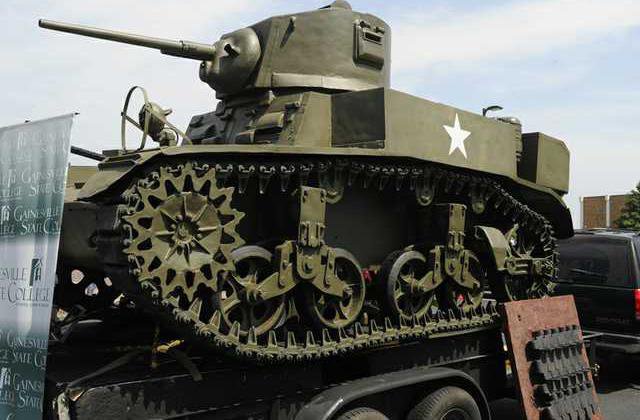OAKWOOD — The olive green tank looked like it could have rolled off the trailer and onto the battlefield.
"We've turned some heads," said one of the Gainesville State College students displaying the replica M3 Stuart tank Monday in the school's parking lot next to the Hugh M. Mills Physical Education Complex.
Confirmation that the tank — used for light combat during World War II — isn't the real deal comes when climbing inside it from the underbelly and finding a hollowed-out interior.
The vehicle is made of fiberglass resin, not metal. Only the bolts and screws are real.
The creation was that of mostly anthropology students under the direction of assistant professor Steve Nicklas.
It was inspired when Nicklas saw a dinosaur bone and a World War II tank track side by side in his lab.
"I've been involved in casting and mold-making for 20 years," he said. "Then, about 15 years ago, I started doing a lot of paleontology things, mostly marine reptiles. (There are) lots of vertebrae and you never find all of them. As a result, you have to replicate the ones that are missing."
He was working on a marine reptile when he noticed part of a German Tiger tank track nearby.
"I collect World War II stuff and I had an exhibit at the college on photographs of (the war) ... and I had some artifacts that went into the cabinet," Nicklas said.
He then realized, "If I can take a mold of that bone, have it cast and make a replica, why can't I do that with the tank track?"
Nicklas approached Fort Benning in Columbus with the idea.
"They asked if we could do a whole Tiger tank, and since there are no Tiger tanks in North America, as a test, they opted for the Stuart," he said.
He and the students made molds, and then Nicklas approached Michael Sincak, president and CEO of Treasure of the Earth in Pennsylvania, on the project.
"He fabricated the resin pieces and my crew went back up (there) to put it together, and then we brought it here and painted it," Nicklas said. "We finished painting it (Sunday)."
Students were happy with the outcome.
"It was a unique experience, something to brag about," said Christian Jacob, laughing.
"I remember when we first saw the original," Joseph Marks said. "I think in photographs, you won't be able to tell the difference."
"At least from 20 feet away," Jacob added.
The finished replica weighs only 2,500 pounds.
"It is basically made out of the same material as a Chevy Corvette, which is strong, durable and rather light," Nicklas said.
He is hopeful the relationship he and Sincak have built with Michael Criscillis, curator of the U.S. Army and National Infantry Museum at Fort Benning, will make it possible for GSC students to take part in internships that will prepare them for careers in artifact identification, preservation and display.
"This fall, I will be teaching ‘Mold Making and the Archeology,' which will explore these techniques and will be a hands-on learning experience for GSC students," Nicklas said.
"Maybe we can get started on that Tiger tank."

